GU-NUT
A locknut that conforms to JIS standards
Features
- In accordance with JIS B 1056 "Prevailing torque type steel nuts".
- Expands friction ring shape to 270°
- A high-torque type that further improves locking functions
- Prevents premature detachment even if the tightening force is lowered
General names
Locknut, Prevailing-torque-type nut
Video of features

Applicable markets
- Two-wheeled vehicles
- Four-wheeled vehicles
- Special-equipped vehicles
- Farm equipment
- Conveyers
- Railways
- Marine vessels
- Plants
- Machine tools
- Industrial equipment
- Electronics
- Medical care and welfare
- Infrastructure
- Civil engineering
- Architecture
- Playground equipment
Structure & Function

Basic Information
Specs
| Steel friction ring | 270° ring |
|---|---|
| Thread accuracy | JIS6H(JIS Class2) |
| Sizes | Sizes: M8 to M16 *Pitch: Coarse thread *Other special sizes |
| Shapes | Type 1 nut (M14 to M16), Type 2 nut (M8 to M12) |
| Materials | SS400 or equivalent |
| Surface treatments | Trivalent Chromate Yellow |
Dimensional Charts and Reference Tightening Torque Charts
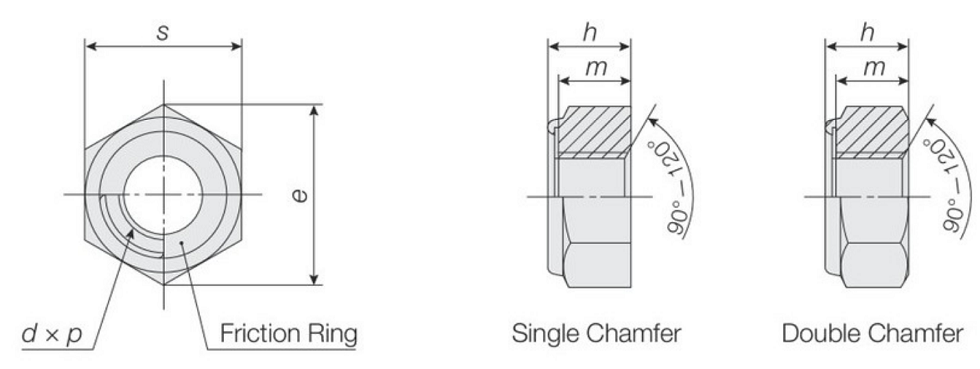
GU-NUT Material of the Nut Body SS400
Dimensional Chart and Reference Tightening Torque Chart
●Available
Thread Accuracy: JIS6H(Class 2) Unit:mm
| Material of the Nut Body | SS400 | ||||||||||
|---|---|---|---|---|---|---|---|---|---|---|---|
| Material of the Friction Ring | SUS301 | ||||||||||
| Nominal Diameter (d) |
Pitch (p) |
Width Across Flat(s) | Overall Height(h) | Thread Height (m) Approx. |
Across Corners (e) Approx. |
Single Chamfer (Type 1) |
Double Chamfer (Type 2) |
Unit Weight (g) Approx. |
Reference Tightening Torque(N・m) Strength Grade:4.8 Surface Treatment: Trivalent Chromate Yellow |
||
| Base | Tolerance | Base | Tolerance | ||||||||
| M8 | 1.25 | 13 | 0 -0.25 |
7.3 | ±0.4 | 6.1 | 15.0 | ● | 5.1 | 18.0 | |
| M10 | 1.5 | 17 | 8.3 | 7.1 | 19.6 | ● | 10.0 | 36.0 | |||
| M12 | 1.75 | 19 | 0 -0.35 |
10.5 | 9.0 | 21.9 | ● | 15.2 | 62.0 | ||
| M14 | 2 | 22 | 12.2 | ±0.5 | 10.4 | 25.4 | ● | 24.0 | 99.0 | ||
| M16 | 2 | 24 | 14.5 | 12.7 | 27.7 | ● | 31.5 | 155.0 | |||
Surface treatments
Installation Instructions
Installation with a wrench
-
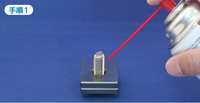
Thread the bolt through the fastening member. Check that the bolt has been chamfered at the tip of the threaded area with a thread accuracy of JIS6g (Class 2). If there is risk of galling or sticking, use lubricant.
-
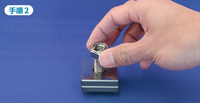
Manually screw the nut on until the friction ring touches the tip of thread portion of the bolt.
*The nut cannot be screwed on from the friction ring side. -
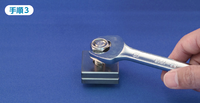
Tighten the nut with a tool such as a wrench/impact wrench. Please refer to the reference tightening torque chart for the tightening torque.Please contact us if you will be using the FUJILOK U-NUT under severe conditions or with low axial force.
-
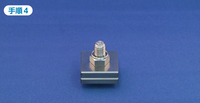
Check that at least two full bolt threads protrude beyond the friction ring. When removing the nut, use a wrench or other such tool to unscrew the nut until the friction ring is separated from the tip of the threaded portion of the bolt.
Installation with an impact wrench
-
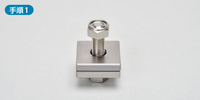
Thread the bolt through the fastening member. Check that the bolt has been chamfered at the tip of the threaded area with a thread accuracy of JIS6g (Class 2). If there is risk of galling or sticking, use lubricant.
-
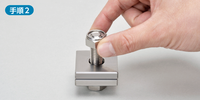
Manually tighten the nut until the friction ring touches the tip of the thread portion of the bolt.
-
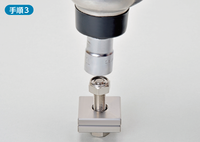
Tighten the nut on at low speed from directly above. Working while the bolt is slanted or installing the nut at high rotating speeds may cause galling.
-
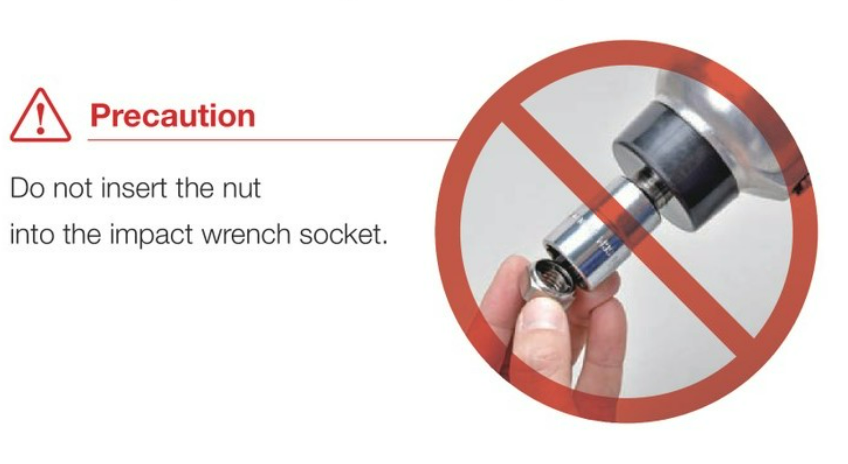
Do not insert nuts into the socket of the impact wrench.
Precautions for Use
This product is used for fastening parts that are especially important.
Please observe the following rules when using this product.
-
Use bolts that have a chamfered tip with JIS6g (Class 2) thread accuracy.
-
Please refer to the reference tightening torque chart when tightening nuts.
-
Use lubricant if there is a risk of galling or sticking when screwing on or unscrewing nuts.
-
To fully demonstrate the locking function of the FUJILOK U-NUT, make sure that at least two full bolt threads come out of the friction ring.
-
When welding a nut, pay attention to sputtering and the effect of heat on the friction ring and bolt threads.
-
Consult us if you are working with bolts with threads that have been machined (with keyways, pin holes, etc.).
-
Use impact wrenches at a medium or lower rotating speed.
-
The nut cannot be screwed on from the friction ring side.
-
Stop using the FUJILOK U-NUT if abnormal deformation or other faults occur on the friction ring and clamp.
-
Consult us before using the FUJILOK U-NUT under severe conditions or with low axial force.
